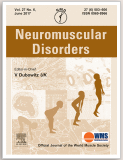 The ADSSL1 gene codes for an enzyme that helps to convert inosine monophosphate (IMP) into adenosine monophosphate (AMP), which in turn is a metabolite needed to produce ATP. ADDSL1 is an enzyme specific to skeletal muscle, where it is highly expressed.
The ADSSL1 gene codes for an enzyme that helps to convert inosine monophosphate (IMP) into adenosine monophosphate (AMP), which in turn is a metabolite needed to produce ATP. ADDSL1 is an enzyme specific to skeletal muscle, where it is highly expressed.
This disease is common in Korea, but is not exclusive to that country. Myopathy related to abnormalities in the ADSSL1 gene was described for the first time in October 2015, in 4 individuals belonging to two unrelated South Korean families. It manifested as an autosomal recessive distal muscle deficit, starting in adolescence and showing slow progression. The cases of nine other Korean individuals presenting this myopathy were subsequently described. Muscle biopsy showed rare occurrences of rimmed vacuoles and occasional rods.
In April 2020, for the first time, an article presented two non-Korean cases of ADSSL1 myopathy, one ![]() involving an individual of Turkish origin and the other an individual of Indian origin. While the manifestations consisted of a distal deficit starting as an adult, and histological and MRI signs similar to the initial description, one of the individuals also presented marked progressive proximal muscle weakness, combined with severe muscle atrophy and muscle-tendon retractions.
involving an individual of Turkish origin and the other an individual of Indian origin. While the manifestations consisted of a distal deficit starting as an adult, and histological and MRI signs similar to the initial description, one of the individuals also presented marked progressive proximal muscle weakness, combined with severe muscle atrophy and muscle-tendon retractions.
A wider spectrum of clinical signs
A Japanese team became interested in the prevalence and phenotype of this disease in Japan.
Based on data collected between January 1978 and March 2019 in the Tokyo (Japan) National Centre of Neurology and Psychiatry (NCNP) database, this team found 63 individuals belonging to 59 unrelated families presenting a clinical picture of muscle deficit combined with abnormalities in the ADSSL1 gene. Among the seven genetic abnormalities found, two were particularly common: one of these two was present on one of the copies of the gene in all 63 individuals.
Clinically, all these individuals had been easily fatigued and not very suited to running in childhood. The majority started to complain of muscle weakness in the lower limbs at a mean age of 24.6 ± 11.4 years, with difficulties climbing stairs or getting up.
- Mean age was 36.6 (5 to 66) years and half were male (37/63).
- More than half (33/63) presented an equal proximal and distal deficit; one third (21/63) had a predominant distal deficit and only 9 individuals had a proximal deficit greater than the distal deficit. Almost four-fifths (41/52) presented an axial or neck deficit.
- 85.7% of individuals could walk without help (mean age of 36.4 years); 4 individuals (mean age of 45.8 years, 25 to 65 years of age) could walk with the help of a walking stick and 5 individuals (mean age of 37.4 years, 22 to 50 years of age) could no longer walk.
- 46 individuals had facial muscle impairment and 24 had dysphagia with difficulty chewing, 3 of which were receiving enteral nutrition.
- 26 individuals had a vital capacity less than 80% (69 ± 22.9%) of the theoretical value, and 7 relied on ventilatory assistance due to hypercapnia.
- 12 individuals presented left ventricular hypertrophy (ECG, echocardiogram). It should be noted that a young man, who died at the age of 25 years from multiple organ failure, had presented signs of left-sided heart failure before the appearance of muscle deficit signs at 20 years of age.
- Two patients had cognitive impairment.
A form of rod myopathy?
Muscle biopsies conducted among 62 individuals showed predominantly in type I fibres:
- rods in 4.3% of fibres on average,
- fatty droplets in almost 33% of fibres on average.
However, these figures are significantly lower compared to those found in conventional rod myopathies or in lipidosis.
Only 24% of patients presented rimmed vacuoles, and only in 2.3% of fibres on average.
This study identifies the widest variety of clinical signs for this myopathy resulting from abnormalities of the ADSSL1 gene. Given the high rod frequency, the authors are proposing to classify this disease under the category of rod myopathies of genetic origin, which would make it the most common form at their centre.
